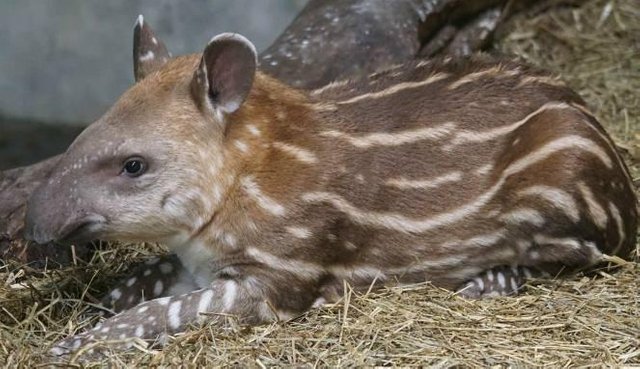A rare animal, Tapir found in the area of Chinese Cemetery, Neighborhood Christian Village, District Kotapinang, Labuhanbatu Selatan Regency, North Sumatra, Monday, December 18, 2017.
The tapirs found are a species of the Malaysian Tapir, or Tapirus indicus.
Tapirs are the most primitive mammals in the world. This animal existed about 20 million years ago and during that time, it did not undergo any significant evolution of body change.
Quoting Live Science, Tuesday, December 18, 2017, judging by its form, Tapir looks like a wild pig with a snout-like shape of a grass. However, these animals are closer to horses and rhinos.
The word Tapir comes from the original Brazilian language which means thick. It refers to the skin of this animal. In Indonesia, Tapir more classified in the family of rhinoceros.
Tapir size is about as big as a donkey. Tapirs have a rounded body, short legs, and a fat tail, like a hippopotamus. Meanwhile, his eyes and ears are small. Tapirs have four fingers on each front foot and three fingers on the hind legs.
One of the distinctive features of Tapir's body is its muzzle. The muzzle function on Tapir is similar to the elephant's trunk. In Tapir, the snout is the upper lip and nose.
According to National Geographic, Tapir uses his flexible muzzle to pick up food, picking leaves and fruit from trees like a trunk on an elephant. Once they can get their food, the muzzle will bring the food to their mouths.
The muzzle also serves as a protector when Tapir is threatened. He would drown himself in the river and use his snout like a snorkel.
So far, there are five species of Tapir that are relatively similar in size. Namely Tapir Baird (Tapiris bairdii / Tapirella bairdii), Tapir Malaysia (Tapiris indicus / Acrocodia indica), Tapir Kobamani (Tapirus kabomani), Tapir of the mountains (Tapirus pinchaque) and Brazilian Tapir (Tapirus terrestris).
Although known to exist five species, but true species Tapir Kabomani into a debate. The International Union for Conservation of Nature (IUCN) does not include the Kabapani Tapir as an endangered species.
Tapirs are herbivorous animals, which consume vegetation such as leaves and fruit. To find traces of water and vegetation, Tapir follows the footsteps created by the other Tapir's feet. Tapirs also dive into the bottom of the watering hole to eat underwater vegetation.
According to IUCN, Tapir has a relatively long pregnancy period in 13 months and female Tapirs only issue one offspring per birth.
Tapir children born weights between 7 to 10 pounds. The Tapir child grew with his striped body motif, a watermelon-like pattern with white chocolate stripes on his body and legs. This body pattern serves as camouflage, but this unique line pattern will disappear as they get older.
This animal measures about 74 to 107 centimeters from foot to shoulder and weights can reach 227 to 363 kilograms.
Tapir children are not weaned within a certain time. Usually the Tapir parent will decide to breastfeed her child about 10 to 12 months after birth. The Tapirs will stop feeding when the mother is ready to have another offspring.
Peak Tapir children grow at the age of 18 months. Tapirs at the age of 2 to 4 years are ready to mate and live for 25 to 30 years.
Of the four Tapir species other than Tapir Kabomani, the IUCN put them in the red list, meaning the species is endangered.
Tapir mountains and Tapir Baird on the list of endangered because the population declined by more than 50 percent in 33 years. The decline of this species is expected to be more than 50 percent within the next 30 years.
Tapir Asia or Tapir Malaysia and Sumateara are also included in the list of extinct, It is estimated that the population decline of this species is more than 50 percent in the next three generations. The threat of extinction is the main factor due to habitat loss.

While the Brazilian Tapir is listed as a vulnerable species, it is estimated that its population has decreased by 30 percent in the last three generations. The population decline is due to habitat loss, poaching and competition with livestock.
IUCN estimates this species will continue to decline for the next three generations.
Tapir Baird is the largest land mammal in Central and South America. The body length of this species is an average of 2 meters. This species has an average height of 73 to 120 centimeters. Tapir Baird adults weigh about 150 to 400 pounds.